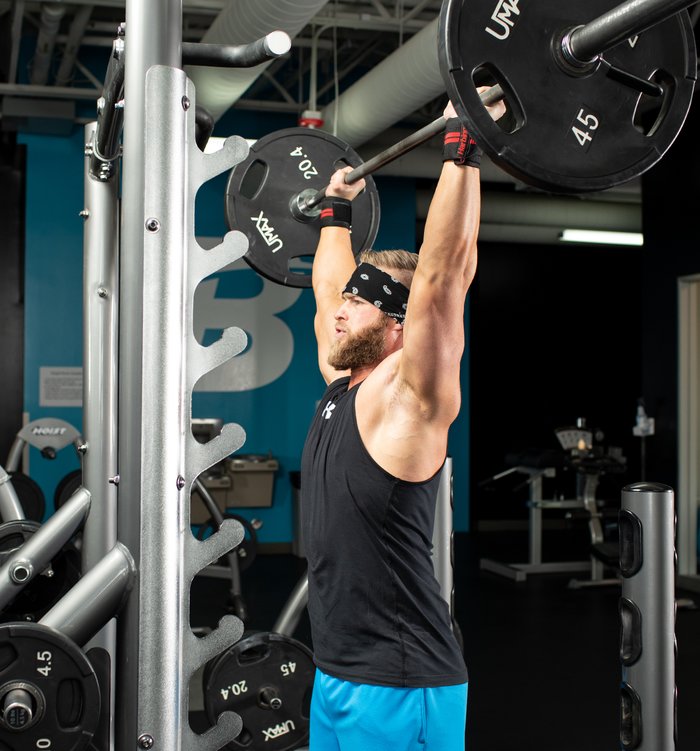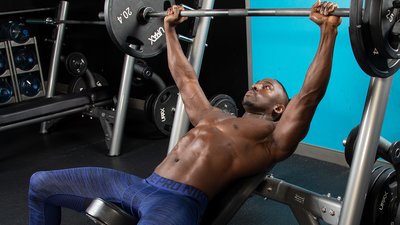The only people who understand the unique struggles big, tall guys have to deal with when it comes to lifting weights, are big, tall guys. Leave it to the smaller crowd to say we’re not working hard enough, and that lifting weights is lifting weights. That couldn’t be further from the truth.
The reason top CrossFit athletes are always 5-foot-10 or below is because they get tasked with moving a given distance for reps, against time, their given distance is smaller than someone six feet or above. I'm open to being proven wrong, but I'm pretty sure you won’t see a 6-foot-9 guy crack out 100 pull ups, 100 squats, 100 deadlifts, and 75 barbell snatches in 10 minutes, no matter how “fit” they are.
But to be clear, no, this is not an excuse for big guys to slack off or accept defeat. It just means they need to take specific steps to ensure their strength training sessions are safe and effective.
Here's where that conversation starts, in regard to the upper body in particular.
Rule #1: Open your mind to other "big presses"
Regardless of the press variation--horizontal or vertical, single-arm or double, explosive or strict--it’s going to be a long way up from the bottom when you have long arms to deal with. That means added time under tension, and more joint stress through bottom end ranges.
Many lifters like to set up ultra-wide on their bench press or strict press to counter this problem and decrease pressing space. But this may not always fix the problem, and many people find that every pound they add in a wide-grip bench comes at the expense of their shoulders.
In the case of a strict military press, using a hand grip that’s too wide will start to frustrate your ability to apply force in the right direction, namely, straight upwards and perpendicular to the floor. Using a grip that’s around shoulder-width apart is something that should remain constant with this movement, as well as to protect your shoulders. However, the more narrow you grip, the longer you have to press.

Big guy option #1: Dumbbell presses
The width conundrum is why I recommend dumbbells for both horizontal and vertical presses for big guys--and actually, for most lifters. One reason, as I explained in my article "5 Hard Truths You Need to Hear About the Bench Press," is that dumbbells do more for chest and shoulder muscle stimulation and growth. More important than this, however, is that dumbbell pressing can place the shoulder joint in a much more desirable position, especially towards the bottom end range of motion due to the fact that you can change your elbow and wrist position as the lift progresses.
This can allow the head of the humerus to externally rotate and reduce the chances of impingement. It’s the same reason that for most people, neutral grip barbell presses feel much more comfortable than standard grip.
Big guy option #2: Pin press
Listen: If you don’t compete, no one’s holding a gun to your head when it comes to your heavy bench. Sure a standard, flat bench press for sets of 1-5 reps is a fine lift, but it’s not the be-all and end-all if you’re looking to move heavy loads for your strength workout. You have other choices.
I recommend trying the simple modification of starting and finishing each rep at a dead stop on pins in a squat cage setup. You’ll probably also find that it proves to be significantly harder than standard benching, since the bar settles between each rep, killing your stretch reflex. Just like pausing at the bottom of a squat, something I recommend in my article "3 Advanced Lifting Techniques that Are Great for Beginners," this can also spur some serious strength gains.
Since you’re stopping a few inches short of the chest, you’ll be able to use a barbell more comfortably through the range of motion. So you'll get that "heavy bench press" feeling.
And by the way, no one’s telling you to make a full switch. Simply mixing it up to even a 50/50 split of heavy pin pressing to heavy bench pressing, or pin pressing and dumbbell pressing, can do wonders for both your shoulders and your overall upper body strength.
Rule #2: Reconsider your Pulling ROM
When it comes to pulling movements–especially chin-ups and pull-downs–the rules of good form also change when it comes to big guys.
Your lats are the key player to make any of these movements useful, but only when you use good technique. A common cue is for these vertical pulls is to keep pulling until face clears the bar entirely. Even better if the collarbone or chest contacts the bar to signify the end of each rep. For guys with T-Rex arms, that’s a great cue. For longer limbed guys, not so much.
Here’s why: The lat attachment is generally high up on the humerus of most lifters. So on a longer arm, there’s probably going to be more space between the lat attachment and the elbow, compared to a shorter arm. That means, during a pull-down or chin-up motion for someone with long arms, the lat may reach full contraction while the elbow is still pretty far away from the torso.
Forcing a greater ROM than your lats are responsible for will only encourage other muscles like the upper traps and biceps to kick in to help out. This isn't a bad thing in and of itself--after all, these muscles are part of the movement--but the more they are powering your pull, the fewer reps you'll be able to manage, and the more you'll limit your lat growth.
To me, all this indicates is that a longer armed lifter would benefit most from stopping a few vital inches shy of “full range of motion," using a feeling of full contraction as his new landmark, rather than physical structures like the torso contacting the bar as his endpoint.
Rule #3: Don't skip isolation work
If you’re 6-foot-5 and all legs and arms, you’re not skeletally built to pack on a ton of muscle on to your frame easily. You probably know that already, though.
It makes sense when you think about it. People with shorter limbs are at a greater advantage when moving heavy loads, which is great for adding strength and also great for sidestepping injury under such loads. Also, having shorter limbs means that adding 2 pounds of muscle to the arms or legs will much more prominently show compared to spreading that mass over a foot more space, like a taller lifer has to.
In the face of challenge, it's crucial to use every tool at your disposal. Isolation training can be your friend, and it’s probably worthwhile to separate yourself from the any ego-attachment you may have to the “big three” movements.
Yes, big lifts are important to do, but they’re probably not going to be your main vehicles for body composition change. Shoulder raises, flyes, upper back work, and direct arm training can all help you as much or more than they help a smaller guy.
Do the right thing, and save room for both heavy work and lots of light lifting. You have my blessing to chase some serious pumps!

